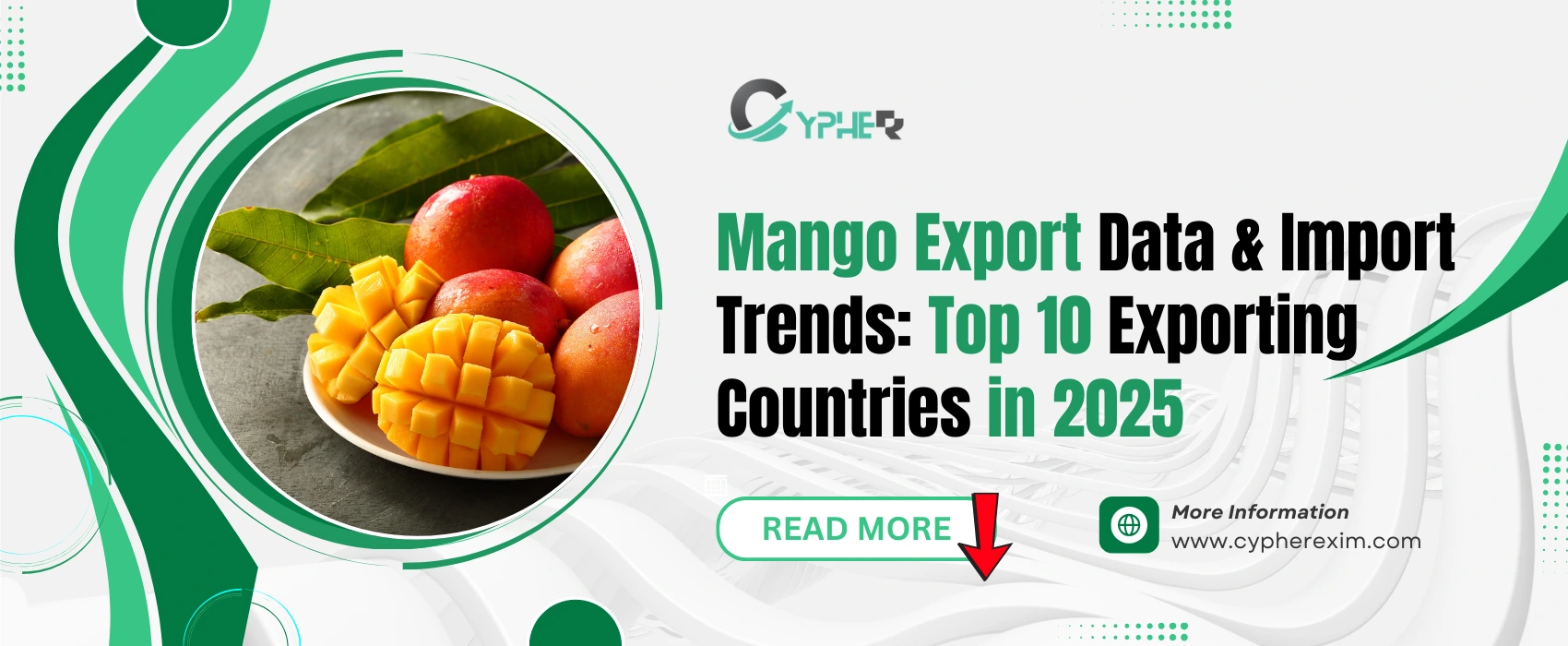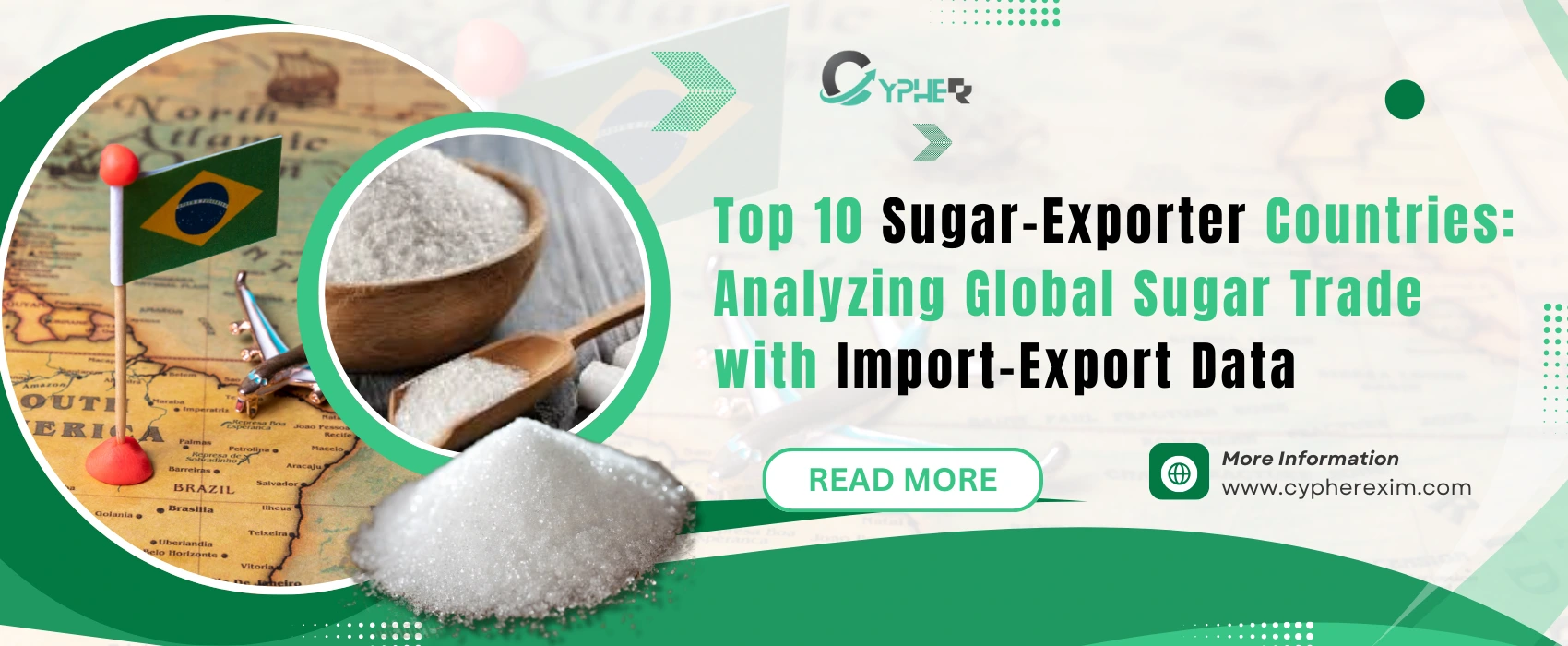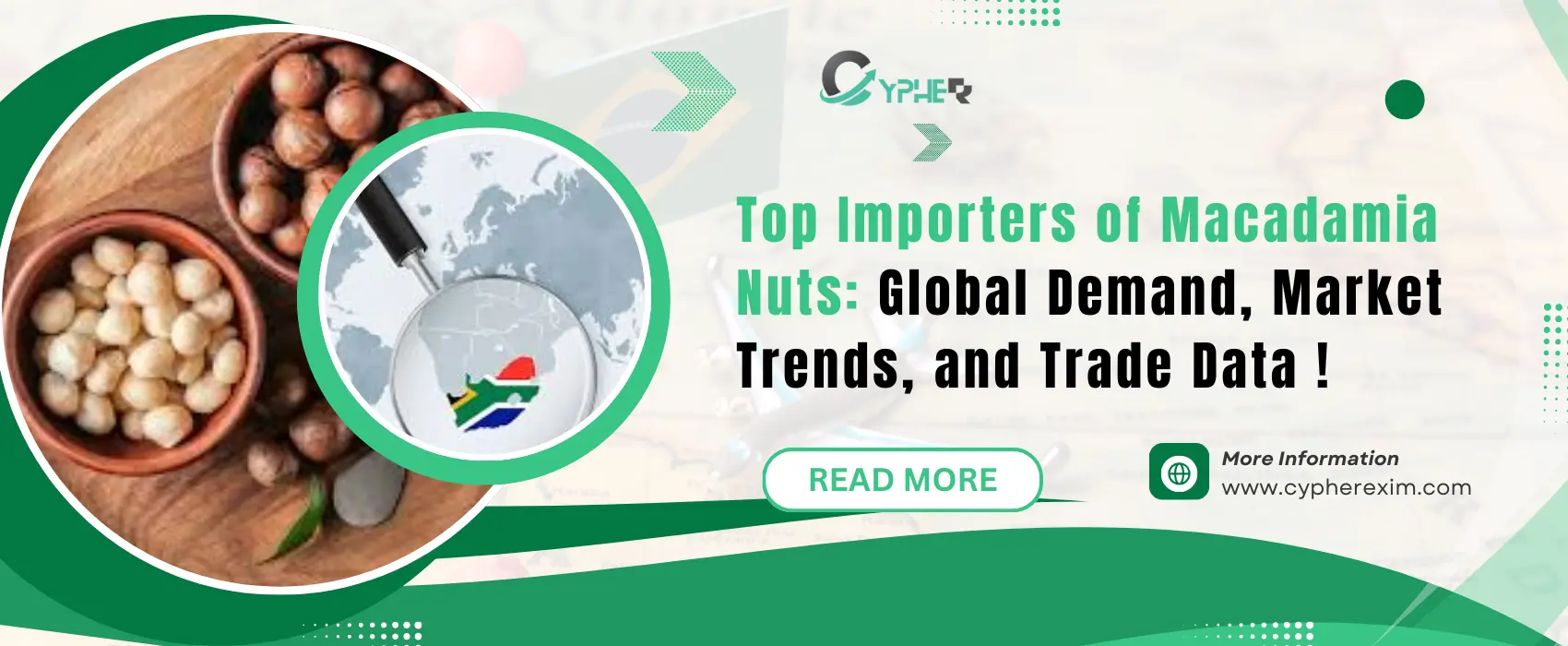Mango Export Data & Import Trends: Top 10 Exporting Countries in 2025

16 May 2025
Mangoes, are known to be the ruler of fruits, the king of fruits, and are loved worldwide for their juicy, sweet flavour and various health benefits. The trade of mangoes has become a significant part of the agricultural economy due to its continued rising demands globally. The market of export and import of mangoes is expected to see robust growth in 2025, driven by increasing global demand, better trade infrastructure, and improved farming techniques. The following blog dives into the latest Mango Export Data to explore and showcase the top 10 exporting countries of mango in 2025 and top trends shaping the industry. We will also explore how our software tool like Cypher and its Mango Export Data By Country, can provide valuable market insights for businesses and stakeholders.
The Global Mango Market in 2025
The global mango market is growing every year, showing an estimated market size of over 98 billion USD by 2031, increasing at a CAGR of 6.21% from 2024 seems to show the market is thriving. After analysing using Cypher, Mango exports seems to show export of 4 billion USD in 2023 globally, with a total production volume of 78.56 billion tons. In the Global Fruit export Market Mangoes hold 4.6% of share which is expected to increase in 2025 as the demand in regions like Europe, North America and Asia is growing up every year. In order to track mangoes and its market demand with trends, the HS code that gets used is (080450) which makes it easier to analyze Mango Export Data and Mango Import Data.
Key factors driving this growth include:- Health Benefits: Mangoes have become a popular choice for health conscious customers as they are rich in vitamin C, Dietary fiber and antioxidants.
- Improved Logistics: Transportation has become hassle free as advances in cold chain technology has made easier to transport export mangoes globally.
- Diverse Varieties: Countries may accommodate a wide range of consumer preferences with more than 1,000 mango types, from Tommy Atkins to Alphonso.
Cypher give companies access to comprehensive mango export data by nation, which aids in supply chain optimisation, competitor tracking, and market opportunity identification.
Top 10 Mango Exporting Countries in 2025
Based on the latest trends and historical data, here are the top 10 mango exporting countries in 2025, along with insights into their contributions to the global market.
1. Thailand
Export Value (2023): $754 million
Key Markets: China, Japan, South Korea
Thailand leads the pack in 2025, thanks to its advanced agricultural practices and proximity to major Asian markets. Varieties like Nam Dok Mai and Mahachanok are highly sought after for their sweet flavor and vibrant color. Thailand’s export volume is expected to grow as demand in China and other Asian countries surges. The country’s focus on quality standards, such as GLOBALG.A.P. certification, ensures its mangoes meet international requirements.
Trend: Thailand is investing in airfreight to deliver premium, tree-ripe mangoes to Europe, commanding higher prices despite increased costs.
2. Mexico
Export Value (2023): $660 million
Key Markets: United States, Canada, Japan
Mexico continues to be a major exporter of mangoes, especially to the US, which receives more than 85% of its shipments. The tropical environment of Mexico is ideal for popular cultivars including Kent, Ataulfo, and Tommy Atkins. Mexico's closeness to North America and established trade networks are projected to keep it in a strong position in 2025.
Trend: In order to comply with more stringent environmental standards in North America and Europe, Mexico is concentrating on sustainable farming methods. Mexican exporters can refine their tactics by analysing U.S. mango import data with the aid of tools such as Cypher.
3. Brazil
Export Value (2023): $450 million
Key Markets: Netherlands, United States, Argentina
Brazil is a major player in the global market thanks to its wide variety of mangoes, which include Tommy Atkins, Keitt, and Palmer. The nation has a competitive advantage because to its year-round production supported by its tropical environment. Brazil's exports to Europe are predicted to rise in 2025, especially through the Netherlands, a hub for re-exports.
Trend: Farmers in Brazil are implementing eco-friendly methods as a result of the growing demand for organic mangoes.
4. Peru
Export Value (2023): $364 million
Key Markets: United States, Netherlands, United Kingdom
Peru has become a significant exporter, and its Haden and Kent types are becoming more and more well-liked in North America and Europe. Investments in irrigation systems and the country's ideal environment have increased output. Targeting upscale European markets is probably how Peru will increase its market share in 2025.
Trend: To appeal to European consumers who care about social issues, Peruvian exporters are using fairtrade credentials.
5. India
Export Value (2023): $220 million
Key Markets: United Arab Emirates, United Kingdom, United States
More than half of the world's mango production—25 million tonnes in 2023—comes from India, the largest producer in the world. However, because of strong domestic demand, only a small portion is exported. A popular export variety is the Alphonso mango, also referred to as the \"King of Mangoes,\" which is followed by Kesar and Totapuri. With the help of government programs like APEDA, India's exports to the Middle East and Europe are predicted to rise in 2025.
Trend: To get into high-value markets like the US and Japan, Indian exporters are getting around phytosanitary restrictions. Indian companies can use Cypher's country-by-country mango export data to find new customers and monitor rival prices.
6. Netherlands
Export Value (2023): $192 million
Key Markets: Germany, United Kingdom, France
Mangoes from Southeast Asia and Latin America are imported into the Netherlands, which then resells them to other European nations. Despite not growing mangoes, it is a major player in the trade thanks to its sophisticated port infrastructure and logistics. The Netherlands will still control the majority of the intra-European mango trade in 2025.
Trend: In response to merchant requests, the nation is implementing more stringent sustainability regulations, such SIFAV.
7. Indonesia
Export Value (2023): $157 million
Key Markets: Singapore, Malaysia, Middle East
Mango exports from Indonesia are increasing thanks to cultivars like Arumanis and Gedong Gincu. Two of its main advantages are its investment in post-harvest technology and its closeness to markets in Southeast Asia. Given the growing demand for tropical fruits in the Gulf, Indonesia is anticipated to focus on these nations in 2025.
Trend: Premium mango varieties in niche markets are the focus of Indonesian exporters.
8. Philippines
Export Value (2023): $120 million (estimated)
Key Markets: Japan, South Korea, United States
The Carabao mango, which is prized for its sweetness and silky texture, is a popular fruit in the Philippines. With the help of trade agreements with North American and Asian markets, the nation's export volumes are anticipated to increase in 2025.
Trend: To increase shelf life and reach far-off markets, the Philippines is investing in cold storage.
9. Pakistan
Export Value (2023): $100 million (estimated)
Key Markets: United Arab Emirates, United Kingdom, Saudi Arabia
High-quality mangoes from Pakistan, such as Sindhri and Chaunsa, are well-liked in Europe and the Middle East. By enhancing phytosanitary compliance to satisfy EU requirements, Pakistan is probably going to boost exports in 2025.
Trend: In an effort to diversify its export base, the nation is investigating processed mango goods such as pulp and dried slices.
10. Guatemala
Export Value (2023): $80 million (estimated)
Key Markets: United States, Central America
Guatemala’s mango exports are growing, driven by demand from the U.S. and neighboring countries. Varieties like Tommy Atkins and Kent are widely cultivated. In 2025, Guatemala is expected to benefit from its proximity to North America and favorable trade agreements.
Trend: Guatemalan exporters are adopting organic certifications to tap into premium markets.
Mango Import Trends in 2025
The mango trade is driven by exports, but it's also critical to comprehend import trends. In 2023, the United States imported $852 million, mostly from Brazil, Peru, and Mexico, making it the top importing nation.
- China: $736 million; important suppliers include Thailand and Indonesia.
- Netherlands: $301 million, serving as Europe's re-export centre.
- $202 million is imported by the UK from Peru and India.
- Germany: $174 million, sourced from the Netherlands and Brazil.
These trends are anticipated to persist in 2025, with China and the United States leading the way because of strong consumer demand. As merchants prioritise sustainable and fairtrade-certified mangoes, the import industry in Europe will expand. Cypher's mango import data can assist importers in finding trustworthy suppliers, tracking pricing trends, and guaranteeing adherence to laws such as phytosanitary certificates.
Key Trends Shaping the Mango Trade in 2025
1. Sustainability and Certifications
Mangoes from sustainable sources are becoming more and more in demand from retailers and consumers. In markets like Europe, certifications like SMETA, fairtrade, and GLOBALG.A.P. are increasingly required. To lessen their carbon footprints and enhance worker welfare, exporters are implementing eco-friendly procedures.
2. High-end and Speciality Types
Higher rates are being charged for premium mango types like Thailand's Nam Dok Mai and India's Alphonso. Despite the greater costs, tree-ripe mangoes are being transported by air to high-value markets.
3. Dominance of Regional Trade
Southeast Asia (Thailand to China) and North America (Mexico to U.S.) account for more than 55% of the global mango trade. Faster delivery times and reduced transportation costs will fuel this trend in 2025.
4. Developments in Technology
Mango shelf life is being increased by cold chain technology, better packing, and post-harvest procedures, which allow exporters to reach far-off markets. Businesses may monitor these technology changes and improve logistics with Cypher's data analytics.
5. Products Made from Processed Mangos
Mango pulp, liquids, and dried mangoes are becoming more and more popular, especially in North America and Europe. These value-added products are being investigated by nations like India and Pakistan in an effort to increase export earnings.
How Cypher’s Export-Import Data Can Help
Access to timely and reliable data is essential for companies involved in the mango trade. Comprehensive information on mango export data, import data, and export data by nation is available on Cypher's export-import data platform. This is how it can be beneficial:
- Market analysis: Determine markets with strong demand and new business prospects.
- Competitor tracking: Keep an eye on the tactics used by leading exporters such as Thailand and Mexico.
- Price Optimisation: Examine market pricing patterns to provide affordable prices.
- Regulatory Compliance: Make sure that sustainability and phytosanitary regulations are followed.
Businesses may keep ahead of the competition in the mango industry, streamline processes, and make well-informed decisions by utilising Cypher's data.
Challenges in the Mango Trade
The mango trade still confronts a number of obstacles in spite of its expansion:
- Phytosanitary Barriers: Microbiological pollution and fruit fly infestations can prevent access to markets such as the EU.
- Climate Variability: Production in nations like India and Pakistan is impacted by erratic weather patterns.
- High Transportation Costs: The cost of shipping premium mangoes by air drives up prices, making them less affordable.
- Market Saturation: Price volatility may result from large exporters' oversupply.
Technology investment, adherence to global standards, and strategic market strategy are all necessary to meet these obstacles.
With Thailand, Mexico, and Brazil leading the list of top mango-exporting nations, the global mango trade is projected to grow significantly in 2025. This surge is fueled by increasing worldwide demand, diverse mango varieties, and advancements in logistics and cold-chain technologies. However, to stay competitive, exporters must navigate challenges such as stringent phytosanitary regulations and evolving sustainability standards.
Businesses can gain a strong advantage, explore new markets, and refine their export strategies by leveraging trusted data platforms like Cypher Exim. Accessing accurate mango export data, mango import data, and mango export data by country helps identify trade trends and forecast opportunities. Additionally, utilizing resources like the Exim Data Bank and verified shipment data India allows companies to analyze trade volumes, assess competitor performance, and optimize supply chain decisions.
In the ever-evolving mango industry, success depends on informed and data-driven strategies. Whether you’re an exporter, importer, or retailer, understanding trade dynamics and relying on credible data sources is key. Staying adaptable and well-informed will ensure long-term growth and profitability in this vibrant and lucrative sector.







